Posted by
Susan Sharma
on
September 26, 2009

I was in Kangra (Himachal Pradesh) late October, just before winter set in. As always, the countryside is ever changing and never fails to reveal something new for my camera to capture. The mongoose family scurrying about the neighbour’s vegetable fields
was amusing.
http://backyard-wildlife.wildbytes.in/#25
So was the sight of giant wood spiders alongside walking paths. The females are nearly ten times larger than the males, I believe. They weave the strongest and largest spiderwebs known to us. Shiny legs with yellow joints are their hallmark. Giant wood spiders
are the subject of research- Humans would love to know the secret of creating the strong golden websilk. "In modern times, the Golden Orb Web Spider’s silk is set to become a major product. The silk is almost as strong as Kevlar, the strongest man-made material
which is drawn from concentrated sulphuric acid. In contrast, spider silk is drawn from water. If we could manufacture spider silk, it would have a million uses from parachutes, bullet-proof vests, lightweight clothing, seatbelts, light but strong ropes, as
sutures in operations, artificial tendons and ligaments. Studies are now being done to have genetically engineered plants produce fluid polymers which can be processed into silk".
http://backyard-wildlife.wildbytes.in/#24
The wild red and white berries were all over.

The fields had spawned metallic mushrooms which vied with the pebbles lying around.

My husband was only too pleased to pose for a photo, framing a wagtail which he was pointing out to me!
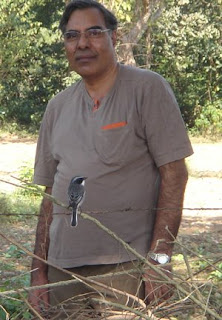 More on my next visit!
More on my next visit!
|
Posted by
Susan Sharma
on
September 26, 2009



The red wattled lapwing is a regular visitor to our neighbourhood park. So I was thrilled to see three spotted eggs on the ground on 5th June. The eggs were laid in the centre of the Park which sees morning walkers doing their rounds every day (who would
not notice the eggs anyway) and young children playing football and cricket in the evenings. To protect the eggs the bird had laid the eggs underneath a tree-guard.
On 9th June, I went to check on the eggs. There was no one in the Park. But I was delighted to see two small chicks with their mother. The mother noticed me as I was still at the gate and started alarm calls. The pitch went higher and higher as I tried to
go close. The chicks scampered in one direction while the mother went in another. Soon the father lapwing appeared on the scene and started shrieking. Then, an amazing thing happened. The chicks suddenly disappeared in the grass and made themselves invisible.
Almost simultaneously, sparrows and Indian robins started flying around the area even as the parent lapwings held on to their spots.
I was mesmerised by this amazing act of community feeling! Needless to say I had to return without a photo. I could not help but feel moved enough to write this blog!
|
Posted by
Susan Sharma
on
September 17, 2009

Sunderbans of West Bengal in India
Sunderbans is the world’s largest delta formed by the river Ganga. Sunderbans comprises 54 tiny lands at present and a number of tributaries of the river Ganga crisscross Sunderbans.
Ghoramara island in the Sunderbans is shrinking due to the rising sea-level. Ghoramara has shrunk from 9 square kilometres to 4.5 square kilometres in the past 30 years as rising sea level and constant erosion of embankment has already uprooted 7,000 inhabitants
leaving another 7,000 in a state of constant fear.
The biggest island, Sagar which hosted refugees from other islands all these years is witnessing massive erosion now. 70,000 people in the 9 sea-facing islands are at the edge of losing land in next 15 years. For these people climate change is real. “Mean
Sea Level”, a documentary made by CSE depicts the threat of erosion the island faces in the wake of rising water levels.
The Union ministry of environment and forests is reportedly preparing measures to protect Sunderbans, the largest mangrove block in the world. According to a report in
Business Standard, short-term and long-term measures for protecting the ecology of Sunderbans would have to be taken.
Venice, which rests on millions of wooden piles pounded into marshy ground, has sunk by about seven centimetres a century for the past 1,000 years.
(According to a study done in 2000 and reported by CNN)
The earth’s natural underground water supplies acted as a cushion that helped slow the city’s sinking.
Venice and its lagoon was added to UNESCO’s World Heritage list in 1987.
The Italian government is spending 4.5bn euro (£2.9bn) on a controversial project to build floodgates across the entrance to the lagoon in which the city stands in an effort to keep the sea at bay. http://travelphotolog.wildbytes.in/#5
|
Posted by
Susan Sharma
on
September 06, 2009
The following news item which appeared in The Hindu today, should make all of us sit up and take notice. Conservation is the most complex subject-It is only when environmentalists and the common man ( here the fishermen) sit together, can solutions
emerge. Otherwise the reactions are bound to be knee-jerk. Or at best imported from a situation elsewhere, where the realities might be very different.
http://www.hindu.com/2009/09/07/stories/2009090753550400.htm
|
Posted by
Susan Sharma
on
August 22, 2009
August 15, Independence Day- An ideal day to check out the hill station near to Chandigarh since we were already in Chandigarh on a visit.
The weather was good. It had rained for two days so the drive up was picturesque. We stopped the car many times just to take in the scenery. On the way we passed many other cars doing the same. Ha! this is like heaven after the hustle bustle of daily life.
Scenic view from nature camp. Double click on the photo and notice the blue water tank on the left.
 Read the full report at the link
Read the full report at the link
http://travelphotolog.blogspot.com
|
Posted by
Susan Sharma
on
August 20, 2009
Here is a visual journey of the total solar eclipse in New Delhi. The Nehruplanetarium at Teenmurti was surrounded by parked cars in hundreds well before 6 AM on 22nd July 2009. The Sun is about to rise and the video camera of an enthusiast or of some
TV channel is hoping to catch it first!
 Young and old alike are waiting for the solar spectacle to unfold.
Young and old alike are waiting for the solar spectacle to unfold.
 At 6.40 AM this is how the sun looked to the naked eye.
At 6.40 AM this is how the sun looked to the naked eye.
 But the screen put up on Teen Murti lawns showed a different picture!
But the screen put up on Teen Murti lawns showed a different picture!
 The secret was to cut out all other light by looking through the unexposed portion of an X-ray film. Some school girls were seen distributing the X-ray films to those who wanted them. Many were also looking through the X-ray film spectacles sold for the purpose.
I decided to put an X-ray film in front of the view finder of my digital camera. Here is what I saw. At 6.44 AM on 22nd July 2009
The secret was to cut out all other light by looking through the unexposed portion of an X-ray film. Some school girls were seen distributing the X-ray films to those who wanted them. Many were also looking through the X-ray film spectacles sold for the purpose.
I decided to put an X-ray film in front of the view finder of my digital camera. Here is what I saw. At 6.44 AM on 22nd July 2009
 At 7.19 AM on 22nd July 2009
At 7.19 AM on 22nd July 2009
 That was truly a "once in a life-time" experience!
That was truly a "once in a life-time" experience!
|
Posted by
Susan Sharma
on
August 20, 2009

 The talk given by Mr.Kapil Sibal, Union Minister for HRD on 29th July 2009 at Teen Murti house, was really `Manna’ to an environmentalist’s ear. The crux of his talk was that `Environment Education’ should be at the center of education, all other knowledge
can follow. All scientific data and processes are available with nature. "Bring science into education; all aspects of science can be learnt from nature. Science taught in correlation with nature is understood best. "Education for sustainable development in
an era of climate change, calls for a change in mindsets. The need is to reach out to communities and have a dialogue. Teachers within the community will have knowledge at ground level". " Teaching of a subject must be holistic. Environmental issues can be
effectively linked to say, automobile engineering. Teaching of music can take off from nature…." " Communicating with nature creates a sense of preservation of nature at the heart of education…" "The government’s aim is to connect all villages of India in
the next three years. This can lead to leapfrog in education. We must be ready with relevant content in the meantime." Heart of all content is nature.
The talk given by Mr.Kapil Sibal, Union Minister for HRD on 29th July 2009 at Teen Murti house, was really `Manna’ to an environmentalist’s ear. The crux of his talk was that `Environment Education’ should be at the center of education, all other knowledge
can follow. All scientific data and processes are available with nature. "Bring science into education; all aspects of science can be learnt from nature. Science taught in correlation with nature is understood best. "Education for sustainable development in
an era of climate change, calls for a change in mindsets. The need is to reach out to communities and have a dialogue. Teachers within the community will have knowledge at ground level". " Teaching of a subject must be holistic. Environmental issues can be
effectively linked to say, automobile engineering. Teaching of music can take off from nature…." " Communicating with nature creates a sense of preservation of nature at the heart of education…" "The government’s aim is to connect all villages of India in
the next three years. This can lead to leapfrog in education. We must be ready with relevant content in the meantime." Heart of all content is nature.
|
Posted by
Susan Sharma
on
May 06, 2008

We also managed an elephant ride into the 20 sq. km rhino enclosure . The rhinos seemed placid , chewing on elephant grass, which came to life with jumping hog deer as we maneuvered our wa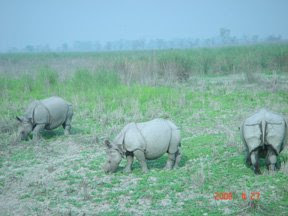 y. y.
The jeep ride into the forest in the evening proved exciting- Herds of swamp deer could be seen from the machan. The deer had shed their antlers, which were sprouting again for the next mating season display. The pugmarks of an adult tigress
and four cubs seemed very recent and we followed them. Sure enough the huge tigress surprised a herd of sitting swamp deer into sudden action. Calls by langur and deer filled the forest air. The whistle of a train came from the distance and a speeding train
could be seen in the horizon view from the machan. The Gonda-Bareilly railway line passes through the National Park. Animals in this reserve must be quite used to this noise by now. One tiger and two elephants died in the tracks recently, Sonu, our guide informed.
Ten trains run through the reserve in one day and every now and then we encountered people collecting fodder and dried wood in the forest. The train station located right inside the reserve carried people in and out regularly making a mockery of National Park
rules.
Tigers and people are living on the edge in this Tiger Reserve, which obviously had a very good prey base. Herds of hog deer and a few barking deer and chital greeted us on the jeep route. Wild hog, another favorite of the tiger also showed themselves often.
Swamp deer herds, which kept near water bodies, avoided tourist routes, but were obviously thriving as well.
Read the full report at
http://www.indianwildlifeclub.com/usercontent/userArticle.asp?id=27
|
Posted by
Susan Sharma
on
May 05, 2008

Dudhwa National Park-26-28 April, 2008
 Anthill in
Dudhwa Anthill in
Dudhwa
Situated on the Indo-Nepal border, in Uttar Pradesh, the Dudhwa Tiger Reserve with an area of 614 sq. Km is one of the few remaining examples of the diverse Terai region. The northern edge of the reserve lies along the Indo-Nepal border and the river Suheli
marks the southern boundary. It is home to a large number of rare and endangered species which includes Tiger, Leopard, Swamp deer, Hispid hare, Bengal Florican, etc.
The grasslands of the reserve are the habitat of the largest kind of Indian deer-the Swamp deer or the Barasingha, so called because of their magnificent antlers (bara-twelve;singha-antler). Decline in their habitats led to a drastic decline in numbers and
a small area named Sonaripur Sanctuary was set aside in 1958 for the conservation of this rare species of deer. Later, it was upgraded to cover an area of 212 sq. km and was renamed the Dudhwa Sanctuary. In 1977, the area was further extended to include over
614 sq. km and was declared a National Park. Eleven years later, in 1988, when Dudhwa became a part of Project Tiger, the area of the Kishanpur Sanctuary was added to create the Dudhwa Tiger Reserve.
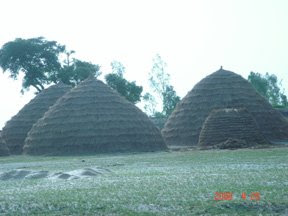
It was the time of wheat harvesting and one could see neatly stacked wheat stalks at several places enroute to Dudhwa via Bareilly from Delhi. We had been told the journey to Dudhwa would be about nine hours. and also that we can expect narrow
roads for about 50 km or so. But the roads we encountered came out to be really bad both on the way up via Shahjehanpur and the way down, when we came via Pilibhit. Fourteen hours by car to a Tiger Reserve one had heard little about!
Once we entered the reserve the roads were well maintained and the first surprise was a meter gauge railway right into the forest, in fact right into the core area as we observed later. Villagers we met at a tea stall were excited that the track had been approved
for conversion into broad gauge.
We had booked our stay in Forest Rest Houses inside the reserve. The place was well lit with CFL bulbs running entirely on solar cells. Even the adjoining staff quarters had solar power.
Early next day we were told that two of the elephants allotted for safari had been requisitioned by Forest Dept for “operation man-eater leopard”. The leopards in Dudhwa lift cattle and turn man- eaters often. Compared to 77 tigers in the Reserve, the leopard
numbers were only ten.
We are allowed to explore the forest in our own vehicle and that is what we did. Smoldering ash from a recent forest fire greeted us first. Soon we glimpsed chital and swamp deer and tiger pugmarks.
We also managed an elephant ride into the 20 sq. km rhino enclosure . The rhinos seemed placid , chewing on elephant grass, which came to life with jumping hog deer as we maneuvered our wa y. y.
The jeep ride into the forest in the evening proved exciting- Herds of swamp deer could be seen from the machan. The deer had shed their antlers, which were sprouting again for the next mating season display. The pugmarks of an adult tigress
and four cubs seemed very recent and we followed them. Sure enough the huge tigress surprised a herd of sitting swamp deer into sudden action. Calls by langur and deer filled the forest air. The whistle of a train came from the distance and a speeding train
could be seen in the horizon view from the machan. The Gonda-Bareilly railway line passes through the National Park. Animals in this reserve must be quite used to this noise by now. One tiger and two elephants died in the tracks recently, Sonu, our guide informed.
Ten trains run through the reserve in one day and every now and then we encountered people collecting fodder and dried wood in the forest. The train station located right inside the reserve carried people in and out regularly making a mockery of National Park
rules.
Tigers and people are living on the edge in this Tiger Reserve, which obviously had a very good prey base. Herds of hog deer and a few barking deer and chital greeted us on the jeep route. Wild hog, another favorite of the tiger also showed themselves often.
Swamp deer herds, which kept near water bodies, avoided tourist routes, but were obviously thriving as well.
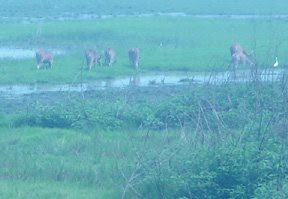
Swamp deer in Dudhwa
The guide pointed out to a distant herd of wild elephants, they are our guests, he said. “They have come from Kosi Tappu wildlife reserve of Nepal”.
A large partridge scampered away. Could it be the swamp partridge? Our guide for the day was not very sure. A serpent eagle displayed itself on a large tree. The cry of the brown headed fishing eagle made us reach for the binoculars. Bird life in the forest
is good though not as plentiful as in Corbett Reserve.
I almost forgot to mention the wildlife spotted near our dwelling. As I was opening the locked room of the forest hut, a sound of something falling behind me made me look back. A pit vper had just decided to drop down from the roof of the verandah. As I moved
away, it started hurtling towards me. Soon, the hot floor made it difficult for it to move. The canteen boys came, swirled it around a stick a few times and then dropped it across the wall of the adjoining forest. What if someone gets bitten, ( vipers seldom
bite though) I asked. The local Hakim has herbal medicines for the bite and they work, he said. According to him, no one he knew died of the bite.
I remembered having read in an article in the BNHS magazine that the violet spikes of Pogostemon bengalensis, seen in the forests around, is the only confirmed herbal antidote for the venom of the viper. Thank God I did not have to try it!
The Reserve is dotted all around with anthills- a sure sign that sloth bear are likely to be around. Though we came across footprints and scat often, the bear himself proved elusive.
The Park did not have too many visitors as many of the forest guest houses were under renovation. A tree house with a good view of “Tiger Tal” is complete and is sure to be a hit with tourists. On the whole, a Park with huge tourist potential, if managed right.
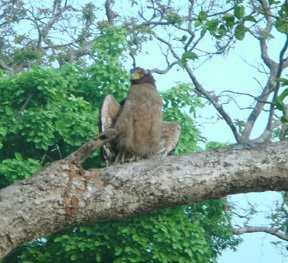
Serpent eagle
|
Posted by
Susan Sharma
on
May 02, 2008
"Such is the lack of information about the biodiversity of Arunachal Pradesh that the
Arunachal Macaque (Macaca munzala) - a species of monkey already known to the native people of Arunachal (especially to the Monpas of Tawang and the tribes of the West Kameng District) as Munzala or the “monkey of the
deep forest”, remained unknown to scientists and biologists till it was “discovered” in 2004. The so called “discovery” was waiting to happen and it was after more than a hundred years that a new species of macaque was discovered (the last recent discovery
being the Indonesian Pagai Island Macaque in 1903)."
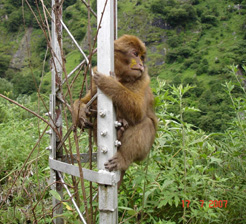
Arunachal Macaque in Tawang (Photo:Govind Singh)
Source:
http://www.indianwildlifeclub.com/ezine/index.asp?m=5&y=2008
|